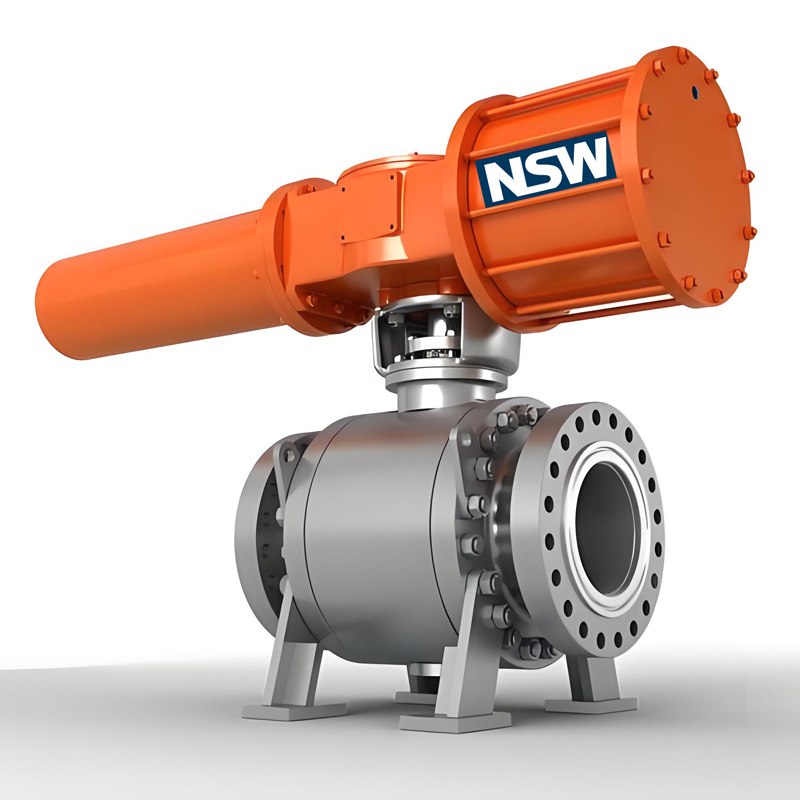Pneumatic Actuated Ball Valves are essential components in a variety of industrial applications, reliably controlling the flow of fluids and gases. Understanding how these devices work is critical for engineers, technicians, and anyone involved in the design and maintenance of fluid systems. This article will take an in-depth look at the mechanics of pneumatic ball valves, their components, and their applications.
What is a Pneumatic Actuated Ball Valve
A pneumatic ball valve is a valve that uses a pneumatic actuator to control the opening and closing of the ball valve. The ball valve itself consists of a spherical disc (ball) with a hole in the center of the ball. When the valve is open, the hole aligns with the flow channel, allowing fluid or gas to pass through. When closed, the ball rotates to block the flow, providing a tight seal.
A pneumatic actuator is a device that converts compressed air into mechanical motion. It usually consists of a cylinder, a piston, and a connecting rod. When air is supplied to the actuator, it pushes the piston, which in turn rotates the ball valve to the desired position.
Components of Pneumatic Ball Valve
- Ball valve: The core component that regulates flow. Ball valves can be made of a variety of materials, including stainless steel, plastic or brass, depending on the application.
- Pneumatic Actuator: This is the driving force for the valve to operate. It can be single acting (requires a spring return) or double acting (uses air pressure to open and close).
- Control system: Includes sensors, switches, and controllers that manage the operation of actuators according to system requirements.
- Air source: Compressed air is the energy source of the actuator. Compressed air must be clean and dry to ensure optimal performance.
- Mounting Pad: ISO 5211 standard, this assembly secures the actuator to the valve, ensuring proper alignment and function.
How does a pneumatic ball valve work
The operation of a pneumatic ball valve can be divided into several steps:
1. Air source connection
The first step is to connect the pneumatic actuator to a source of compressed air. The air supply is usually regulated to ensure a steady pressure, which is critical to the performance of the actuator.
2. Activate the actuator
When the control system sends a signal to the actuator, compressed air enters the actuator’s cylinder. In a double-acting actuator, air is supplied to one side of the piston, causing it to move in one direction. In a single-acting actuator, when the air pressure is released, a spring mechanism will return the piston to its original position.
3. Ball rotation
When the piston moves, it is connected to a rod, which rotates the ball valve. The rotation of the ball is typically 90 degrees, transitioning from the open position to the closed position. The design of the actuator ensures that the ball moves smoothly and quickly, resulting in a fast response time for fluid control.
4. Traffic Regulation
Once the ball valve is in the desired position, the flow of fluid or gas is either allowed or blocked. The tight seal created by the ball valve ensures minimal leakage, making it an effective choice for controlling flow in a variety of applications.
5. Feedback Mechanism
Many pneumatic ball valves are equipped with feedback mechanisms that provide information about the valve position. The control system can use this data to make adjustments or to signal the operator about the valve status.
Advantages of Pneumatic Ball Valve
Pneumatic ball valves have several advantages over other types of valves:
- Speed: They can open and close quickly, making them ideal for applications where fast flow control is required.
- Precise: The ability to accurately control valve position allows for precise flow regulation.
- Reliability: Pneumatic systems are less prone to failure than electric actuators, especially in harsh environments.
- Safety: In the event of a power failure, pneumatic actuators can be designed to return to a fail-safe position, enhancing system safety.
- Versatility: They can be used in a variety of applications including water treatment, chemical processing, and HVAC systems.
Application of Pneumatic Ball Valve
Pneumatic ball valves are widely used in various industries, including:
- Oil and Gas: Used to control the flow of crude oil, natural gas and other hydrocarbons.
- Water Treatment: In systems where precise flow control is required for filtration and chemical dosing.
- Food and Beverage: Managing the flow of liquids and gases during processing and packaging.
- Pharmaceuticals: Used to maintain sterile conditions and precise processes during the manufacturing of pharmaceuticals.
- HVAC: Used to regulate air flow in heating, ventilation, and air conditioning systems.
in conclusion
Understanding how pneumatic ball valves work is essential for anyone involved in fluid control systems. These valves combine the reliability of pneumatic actuators with the efficiency of ball valves, making them a popular choice in a variety of industrial applications. Their ability to quickly and precisely control fluid flows ensures that they will continue to play an important role in modern engineering and manufacturing processes.
Post time: Feb-13-2025


